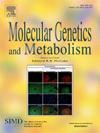20例中国PMM2-CDG患者的多器官累及及遗传谱分析
IF 3.5
2区 生物学
Q2 ENDOCRINOLOGY & METABOLISM
引用次数: 0
摘要
目的糖基化(CDG)最常见的先天性疾病是磷酸腺苷转氨酶2 (PMM2)缺乏症(PMM2-CDG)。PMM2-CDG是一种复杂的遗传性疾病,常见于婴儿期或幼儿期,临床表现为神经和非神经症状的异质性。为了扩大PMM2-CDG的表型和遗传谱,我们总结了20例中国患者的特征。方法对所有患者进行遗传诊断。回顾性分析临床特征、基因型、影像学、电生理和代谢数据。结果纳入PMM2-CDG患者,男性12例,女性8例。诊断时的中位年龄为12.0(6.0 ~ 52.0)个月,而最终随访时的中位年龄为10.3(5.1 ~ 12.8)岁。所有患者均出现多系统症状,并观察到各种神经系统症状。发育迟缓是主要的初始症状。运动障碍、生长迟缓和肝损害也是常见的表型。小脑萎缩是脑影像学上的特征性异常。共鉴定出14个PMM2基因变异,其中5个为c.82A >;G (p.M28V), c.551C >;T (p. 184l), c.640G >;T (p.G214C), c.656A >;T (p.E219V)和c.712C >;G (p.R238G),均为新报道。最流行的变体是公元430年T比;C (p.F144L),在65.0%的患者中被识别,其次是C .395T比;C (p.I132T)。与其他人群的报告一致,错义变异构成了PMM2基因改变的主要类型。结论pmm2 - cdg是一种临床表型多样的多系统疾病,对早期识别和诊断提出了挑战。该中国队列中最常见的致病变异是c.430T比;C (p.F144L),与常见致病变异C . 422g >;A (p.R141H)在欧洲PMM2-CDG患者中。本文章由计算机程序翻译,如有差异,请以英文原文为准。
Multiorgan involvement and genetic spectrum of 20 Chinese patients with PMM2-CDG
Objective
The most common congenital disorders of glycosylation (CDG) is the phosphomannomutase 2 (PMM2) deficiency (PMM2-CDG). PMM2-CDG is a complex genetic disorder that often found in infancy or early childhood with a clinically heterogeneous variety of neurological and non- neurological symptoms. To expand the phenotypic and genetic spectrum of PMM2-CDG, we summarized the characteristics of 20 Chinese patients.
Methods
All patients were diagnosed by genetic analysis. Clinical characteristics, genotypes, imaging, electrophysiological, and metabolic data were analyzed retrospectively.
Results
Twelve males and eight females with PMM2-CDG were included. The median age at diagnosis was 12.0 (ranging from 6.0 to 52.0) months, while the median age at final follow-up was 10.3 (ranging from 5.1 to 12.8) years. All patients exhibited multisystem symptoms and various neurological symptoms were observed. Developmental delay was the primary initial symptoms. Dystaxia, growth retardation and liver damage were also common phenotypes. Cerebellar atrophy was the characteristic abnormality on brain imaging. Fourteen variants of the PMM2 gene were identified, of which five, c.82A > G (p.M28V), c.551C > T (p. P184L), c.640G > T (p.G214C), c.656A > T (p.E219V) and c.712C > G (p.R238G), were newly reported. The most prevalent variant was c.430 T > C (p.F144L), which was identified in 65.0 % of patients, followed by c.395 T > C (p.I132T). Consistent with reports from other populations, missense variants constituted the predominant type of PMM2 gene alterations.
Conclusion
PMM2-CDG presents as a multi-system disease with diverse clinical phenotypes, posing challenges to early identification and diagnosis. The most common pathogenic variant in this Chinese cohort was c.430 T > C (p.F144L), which is close to, but different from, the common pathogenic variant c.422G > A (p.R141H) among European PMM2-CDG patients.
求助全文
通过发布文献求助,成功后即可免费获取论文全文。
去求助
来源期刊

Molecular genetics and metabolism
生物-生化与分子生物学
CiteScore
5.90
自引率
7.90%
发文量
621
审稿时长
34 days
期刊介绍:
Molecular Genetics and Metabolism contributes to the understanding of the metabolic and molecular basis of disease. This peer reviewed journal publishes articles describing investigations that use the tools of biochemical genetics and molecular genetics for studies of normal and disease states in humans and animal models.
 求助内容:
求助内容: 应助结果提醒方式:
应助结果提醒方式:


